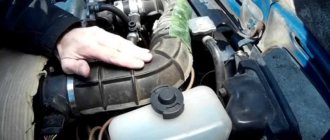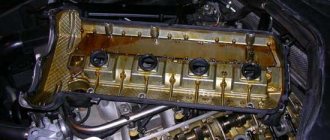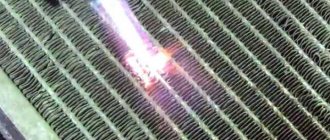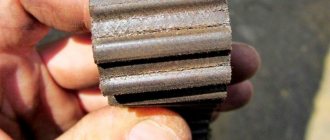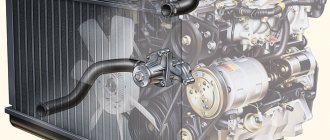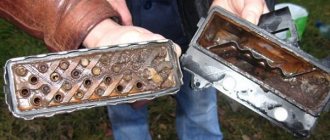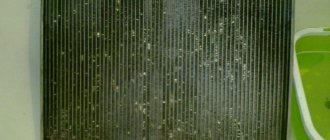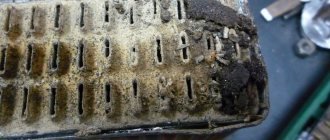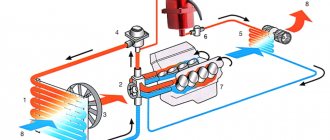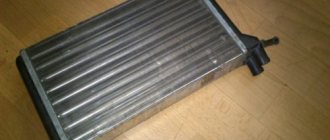Author: Evgeny Zhivoglyadov. Publication date: December 15, 2022. Category: Automotive equipment.
The radiator is one of the main components of the car engine cooling system. Even minor damage to it leads to antifreeze leakage. And, this, in turn, threatens to overheat the engine (with all the ensuing negative consequences). Therefore, timely elimination of radiator leaks is a measure that must be carried out immediately in order to further safely operate the vehicle. Repairs (both temporary and long-term) of this unit can be completely carried out independently. How to do it? This will be discussed in our article.
Determining the location of the leak
If the coolant “leaves”, you will immediately know about it by opening the hood and finding a drop in its level on the expansion tank below o.
Next, you need to determine the location of the leak. To do this we do the following:
- Add antifreeze to normal level.
- Warm up the engine to operating temperature.
- We park the car on a flat and dry surface.
- Let the engine cool down.
- We look for where drops of liquid fall under the bottom and carry out a visual inspection of the entire cooling system.
If you are convinced that it is the radiator that is leaking, then it is necessary to take urgent measures to eliminate this malfunction and only then continue to operate the car.
Danger of leakage
Many drivers do not know the dangers of coolant leakage. Let's explain clearly.
As soon as a leak forms in the radiator, the antifreeze stops removing heat. As a result, the engine overheats. At the same time, the cylinder head changes configuration, which is guaranteed to lead to gasket failure.
In addition, the “engine” can become severely jammed at one moment, which will certainly lead to a major overhaul. The lack of coolant in the radiator is dangerous for the driver.
If a person opens the hood when a problem is detected, the boiling liquid forms a kind of geyser. Once on the skin, hot drops will cause a burn.
Methods for eliminating identified cooling radiator malfunctions
There are several ways to fix a radiator leak:
- The use of folk remedies (only if you are located at a considerable distance from the nearest spare parts store).
- The use of special sealing agents that temporarily eliminate leaks in the cooling system.
- Repairing a damaged unit using soldering or special adhesives.
- Replacing a damaged radiator with a new one.
Important! The first two methods are purely a temporary measure that allows you to continue operating the vehicle without the risk of engine overheating.
What can happen if there is a lack of coolant?
If the radiator leaks or the pipe ruptures, the following may happen:
- The engine will overheat;
- The cylinder head gasket is deformed;
- When attempting to examine the problem, pressurized liquid may splash into the face, causing burns;
- The engine will seize.
All these troubles can lead to expensive repairs, and damage to health can be irreparable.
Folk remedy
If a radiator leak is discovered on the road, then you can get to the nearest grocery store, buy mustard powder or ground red (or black) pepper, and use the proven “old-fashioned” method, which was successfully used even by professional drivers when auto chemicals and its developments did not yet have such wide application.
The method of manufacturing and subsequent use of a homemade repair composition is quite simple:
- Pour mustard powder or ground pepper into a suitable container (at the rate of 1 g per 1 liter of cooling system volume).
- Pour 200÷300 ml of antifreeze or distilled water into it.
- We start the engine, let it run until it reaches operating temperature and turn it off.
- Carefully open the radiator cap (observing the necessary precautions).
- Shake the container with the homemade repair composition and pour the contents inside the unit.
- We start the engine again and let it run for another 15–20 minutes.
Particles of organic matter temporarily stop small holes or cracks that have formed in the radiator: this will allow you to safely reach your destination and carry out a full repair there.
Important! After a complete repair, the entire cooling system must be flushed using special compounds, and only then new antifreeze must be added.
Without removing the panels
There are many options for replacing a radiator without removing the panel. Let's focus on one of them.
1. The first thing we need is sufficient room for action, namely the ability to fully open the driver's door.
2. After this, open the hood to disconnect the air filter along with the air duct, and also remove the battery along with the platform.
3. Drain the antifreeze.
Remember that it is under pressure while the engine is running. Therefore, carry out all actions after first making sure that nothing threatens your health. Wait until the engine has completely cooled down.
4. Now you can dismantle the old radiator.
We disconnect the pipes attached to the engine fittings. Then we find the same fittings, but on the heater radiator, and remove the pipes from them. Thus, we disconnected the two hoses leading to the stove.
Having completed these simple operations, you will notice that between the hoses there is a nut with which the metal casing is attached to the engine shield. It needs to be unscrewed.
Replacing the heater radiator on the Kalina is in full swing.
Remove the gas pedal and loosen the nuts on the brake pedal to move it a little to the side for easier work. Why don't you remove the brake pedal? Firstly, this is not the first need, the pedal won’t hurt much, and secondly, you won’t be able to remove it anyway.
So, we have completely freed up space and can now remove the old radiator.
5. We install a working part.
When you pick up a new radiator, you will immediately understand that it does not want to go back to its original place. The plastic tubes attached to the structure are in the way.
What to do? We cut them about a centimeter. During dismantling, we removed the hoses, which means we need to put them back in place. Before doing this, heat the plastic edges of the tubes with a regular lighter, and then press them against any surface, preferably metal, so that an obstacle is formed and the hoses do not jump off in the future.
Types of radiator sealants
The modern market for auto chemical products is replete with various sealants for eliminating minor damage to radiators. They are produced in the form:
- powder;
- tablets;
- liquids.
According to their intended purpose, such funds are divided into:
- highly specialized;
- universal.
The former are intended for emergency repair of radiators made of either copper (for example, Bar's Leaks Block Seal Liquid Copper) or aluminum (for example, Rislone Liquid Aluminum Radiator Stop Leak). Using the latter (for example, K-Seal ST5501) you can eliminate leaks in the entire cooling system. Moreover, they can be used regardless of the material from which the radiator is made.
Reviews of the use of such drugs vary widely: from the most enthusiastic to the purely negative. The truth is, as usual, somewhere in the middle. It is important to remember that eliminating a leak using one of the proposed drugs is a temporary measure: it only allows you to continue using the car for a period of 2–3 days to several months.
Results
Having completed all the work and enjoyed the warmth in the cabin, we can say that replacing the heater radiator on a Kalina does not take as much time as it seemed. And the invaluable experience gained during repair work allows you to be proud of yourself and your skills.
For those blog readers who subscribe to my YouTube channel, this article will not be new, since I already told you everything in the video review. Well, for those who only read the blog, I will describe my personal experience in using sealants here.
So where did it all start? The windows began to fog up, and the search for the cause indicated that it was a leak from the heater radiator that was to blame. The recirculation flap was in the "correct" position, the cabin filter was fine, and was replaced a couple of months ago. When antifreeze began to drip in the area where the heater radiator was installed, there was no longer any doubt about its leakage.
Popular sealants for car radiators
Today, the most popular among Russian car enthusiasts are three types of liquid sealants designed to eliminate small leaks in the engine cooling system: “Liqui Moly Kühler Dichter”, “Hi-Gear Radiator Stop Leak” and “Wynn’s Cooling System Stop Leak”.
The method of application for the above compositions is approximately the same:
- We warm up the engine to operating temperature (so that the thermostat opens and the coolant circulates in a “large cycle”).
- Unscrew the radiator cap (observing safety precautions).
- Thoroughly shake the container with the sealant and pour it into the coolant.
- We install the plug in place.
- Let the engine run for another 15÷20 minutes (until the leak stops).
- If necessary, add antifreeze (to normal level).
The cost of one bottle of liquid gemetic (capacity 250÷325 ml), designed for the volume of the cooling system of a passenger car (from 5 to 12 liters) varies from 300 to 400 rubles. According to the manufacturers, the above compositions are compatible with all types of antifreeze currently used in cooling systems.
Causes of leakage
In fact, a leaking radiator becomes like this for several reasons. All “breakdowns” are conventionally divided into two categories: mechanical and natural.
Mechanical accidents include accidents with a frontal collision, which result in a breakdown. Also included in the category are repair “interventions” by non-professional craftsmen. Often, after poorly performed work, various parts and assemblies are damaged, which causes leaks.
Natural “strips” include corrosion processes. Over time, even a small scratch can turn into a strong source of corrosion, so you need to respond to such places in a timely manner. Otherwise, a hole will appear in the system through which refrigerant will begin to leak.
There are several ways to check a radiator for leaks:
Before you go on the road, and also while driving, you need to look at the coolant level.
Inspect the system from time to time to detect cracks.
Keep pressure and temperature under control, and respond promptly to warning lights.
If the cooling radiator leaks, what should you do in this situation? If the driver is “on the road”, then you can fix the problem yourself. But if possible, you should contact a service center, where technicians will diagnose and eliminate the leak.
Preparatory stage of radiator repair
Before you begin repairing the radiator yourself, it is necessary to carry out a number of preparatory measures:
- Drain the antifreeze from the cooling system.
- We dismantle the radiator, clean it of dirt and dust and rinse it thoroughly.
- We “muffle” all technological openings (inlet and outlet) using improvised means (for example, pieces of plastic film and electrical tape).
- We lower the radiator into the bathtub filled with water.
- Based on the air bubbles rising to the top, we determine the location of the damage.
When the “problem” areas are clearly identified and the radiator is thoroughly dried, you can immediately begin the repair process.
Soldering a copper or brass radiator
Repairing minor damage to radiators made of copper or brass is quite simple. For this you will need:
- Gas burner (the simplest nozzle for a cylinder costs only 200–250 rubles).
- Solder paste (for example, ZIL-2 or ST-61).
- Tin-based solder (POS-30, POS-40 or POS-60).
Work algorithm:
- We clean the damaged areas using sandpaper and needle files.
- We warm them up using a gas burner.
- Apply a layer of solder paste or acid.
- We apply a solder rod to the hole or crack and continue to heat the soldering area with a gas torch.
- We make sure that the melting solder evenly fills all damaged areas.
- After complete cooling, remove excess tin mechanically.
- We close all the holes of the radiator, lower it into a bath filled with water, and make sure that there are no air bubbles in the soldering areas.
Repair of aluminum radiators
Until recently, exclusively special oxygen-free argon welding was used to repair products made of aluminum and its alloys. This was due to the fact that after mechanical cleaning of the damaged area, an oxide film instantly formed on the surface of the material, which made soldering difficult. Nowadays, with the advent of low-temperature solders (Durafix or HTS-2000), designed specifically for soldering aluminum, repairing a radiator made of this metal at home does not present any particular difficulties:
- We clean the damaged areas mechanically.
- We degrease them with alcohol or solvent.
- We heat the damaged area using a gas burner.
- We press a rod of special solder tightly against it and carry out reciprocating movements. By doing this, we remove the layer of oxides from the surface, and the solder, which melts upon contact with the heated surface, reliably “blocks” the radiator leak.
How can you seal a car radiator?
The use of “cold welding” or special adhesive compositions is also a very effective measure to extend the “life” of your car’s radiator. Work algorithm:
- Use a narrow screwdriver to widen the crack.
- We thoroughly clean it with needle files or sandpaper and degrease it.
- We mix the “cold welding” components (“Poxypol”, “Moment”, “Arbo” or the like).
- Fill the gap with the prepared solution and leave the knot for a day to dry completely.
- We check the radiator for leaks and install it in place.
Damage to radiators (made from a wide variety of materials) can be quickly and effectively repaired using a special Hosch-Kleber repair compound. The delivery set includes two containers:
- one with liquid adhesive;
- the other with special welding granulate.
How to use this tool to repair a car radiator is described in the video below:
A little about the device
It just so happens that Russian winters are some of the coldest, which means cars should be produced taking this little feature into account. In such weather conditions, the undoubted advantage of the Kalina is its powerful stove. It will not only bring the interior temperature to an acceptable minimum in a matter of minutes, but will also warm its owner with the warmth of the Russian automotive heart. However, there is a small drawback to this device - over time, you begin to notice how the main heat source leaks, forming oily drops on the rubber mats.


